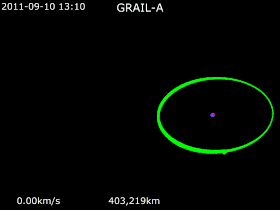
GRAIL-A · Moon · Earth
A low-energy transfer, or low-energy trajectory, is a route in space that allows spacecraft to change orbits using significantly less fuel than traditional transfers.[1][2] These routes work in the Earth–Moon system and also in other systems, such as between the moons of Jupiter. The drawback of such trajectories is that they take longer to complete than higher-energy (more-fuel) transfers, such as Hohmann transfer orbits.
Low-energy transfers are also known as Weak Stability Boundary trajectories, and include ballistic capture trajectories.
Low-energy transfers follow special pathways in space, sometimes referred to as the Interplanetary Transport Network. Following these pathways allows for long distances to be traversed for little change in velocity, or delta-v.
- ^ Belbruno, Edward (2004). Capture Dynamics and Chaotic Motions in Celestial Mechanics: With Applications to the Construction of Low Energy Transfers. Princeton University Press. p. 224. ISBN 978-0-691-09480-9.
- ^ Belbruno, Edward (2007). Fly Me to the Moon: An Insider's Guide to the New Science of Space Travel. Princeton University Press. pp. 176. ISBN 978-0-691-12822-1.